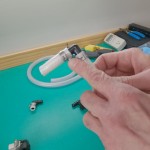This post may contain affiliate links.
So, the Clear RV Black Tank experiments have proven to be pretty popular. That’s great! They also generate a lot of comments and suggestions. Some of the suggestions are awesome, and I’m using them to continue to improve the experiments. Some of them, I can’t address – due to time or expense or safety issues.
But some of the critiques just keep coming back. In this video, I try to address two of the most common suggestions I get on these experiments. Namely:
- The Clear RV Black Tank is set up too high off the ground. The straight shot dumping creates a “too good to be true” scenario for emptying the tank.
- The Clear RV Black Tank is too deep. The extra depth makes things dump more cleanly than they regularly would.
So, I came up with some (very silly) tests to determine if these really did matter, and that’s what you’ll see in the video.
And not to spoil it or anything, but based on these results… I’m not changing anything.











Regarding the argument that the elevation difference between the tank bottom and the end of the hose affects the drain time, this would be true for a small drain line (1″?) that provides significant resistance to flow but not for a 3″ line where the friction loss in the line is negligible. With a 3″ hose, the only significant resistance to flow is at the tank discharge opening. Imagine a discharge opening consisting of the entire bottom of the tank. Discharge would be instantaneous.
I had a nasty experience with my black tank a few months ago. Poo sprayed out like a fire hose! Not fun haha.
Clogged vent pipe?
James,
You asked what model of rv I had…it’s stated in my response- you didn’t miss anything.
Drew
Oh! Got it. Picture me slapping my palm to my forehead. I sometimes approve the comments out of context, and couldn’t see that it was in response to my previous question. Let’s call it a “Webmaster Moment”… Thanks!
Watching your Professor Poo video with great interest. Being first time RVers, we were worried that we weren’t getting a complete emptying of the black tank as per the tank gauges. I suspected that it was actually residue stuck to the sensors and researched that on rv.net.
I found this cleaning technique called The Geo Method involving Calgon water softener and dishwashing liquid. I tried it and indeed after flushing the solution out, the tank sensors read empty.
I expect someone has suggested this, but how about giving it a try with your clear experimenting tank? Add some level sensors for accuracy.
Actually, I do intend to try out that method in the clear tank soon, along with a few others. Stay tuned!
I like your videos…as for the complaints and comments…I think they’re from people that can’t figure out things for themselves. Sure I see differences in how I would conduct an experiment but the fact that you did them allows others to extrapolate your data to their situation…if they can’t then poo on them.
dotdotdot
Hey! It’s nice to hear from someone that “gets it”. Appreciate the support. James
James,
You don’t need to test this but my black tank has an outlet that is on the bottom of the tank (not out the side). I think that would also aid in having a more complete evacuation of the tank, what do you think?
Good work and thanks!
Drew
Hey Drew – Outlet on the bottom is a great idea. Even apart from any pressure/flow impacts – with an outlet on the bottom, you could slope the floor of the tank to really guide things out. I like the way your manufacturer was thinking. What model RV do you have?
Winnebago Sightseer
OK. Yes. Winnebago Sightseer. Did I miss something?